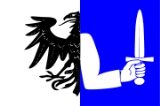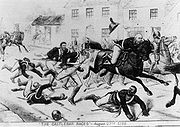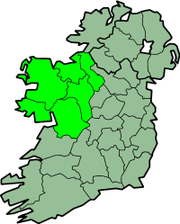
Republic of Connaught
Encyclopedia
The Irish Republic, more commonly referred to as the Republic of Connacht, was a short-lived Irish
breakaway state established with French Directory
military support for 13 days during the Irish Rebellion of 1798
.
, the French General who led the French and Irish armed forces in the short-lived Republic. The proclamation was made on 22 August 1798, the day the General first landed in County Mayo
, Ireland
:
The above decree refers to an Irish Republic, not a Republic of Connacht. Hence, strictly speaking, it appears to be incorrect to refer to any formal establishment of a Republic of Connacht. Instead, an Irish Republic had been proclaimed. On 31 August 1798, General Humbert proclaimed the establishment of a government for one of the provinces of the Irish Republic, Connacht. Humbert also selected John Moore
as the President of the Government of the Province of Connacht. Nevertheless, as civil or political appointments were not made for any other province except Connacht, the Republic of Connacht is the name for the 1798 Irish Republic that has long been commonly used.
 There was little effective government, given the state's brief and troubled existence. Whether it was ever recognised by France is unknown: the French supported the United Irish who aimed to establish an island-wide republic. Some of the principal events in the short lived Republic were the following:
There was little effective government, given the state's brief and troubled existence. Whether it was ever recognised by France is unknown: the French supported the United Irish who aimed to establish an island-wide republic. Some of the principal events in the short lived Republic were the following:
 Although achieving a spectacular victory at Castlebar, the losses of the French and Irish were high, losing about 150 men, mostly to the cannonade at the start of the battle. The British suffered over 350 casualties of which about 80 were killed, the rest either wounded or captured, including perhaps 150 who joined the rebels. Following the victory, thousands of volunteers flocked to join the French who also sent a request to France for reinforcements.
Although achieving a spectacular victory at Castlebar, the losses of the French and Irish were high, losing about 150 men, mostly to the cannonade at the start of the battle. The British suffered over 350 casualties of which about 80 were killed, the rest either wounded or captured, including perhaps 150 who joined the rebels. Following the victory, thousands of volunteers flocked to join the French who also sent a request to France for reinforcements.
Ultimately defeated by Cornwallis
at the Battle of Ballinamuck
, the republic ceased to exist and the Kingdom of Ireland
was later absorbed into the United Kingdom of Great Britain and Ireland
in 1801.
Though seemingly an anecdotal episode in modern Irish and British history, it was remembered locally as a landmark event and part of the heritage of "The Year of the French".
Ireland
Ireland is an island to the northwest of continental Europe. It is the third-largest island in Europe and the twentieth-largest island on Earth...
breakaway state established with French Directory
French Directory
The Directory was a body of five Directors that held executive power in France following the Convention and preceding the Consulate...
military support for 13 days during the Irish Rebellion of 1798
Irish Rebellion of 1798
The Irish Rebellion of 1798 , also known as the United Irishmen Rebellion , was an uprising in 1798, lasting several months, against British rule in Ireland...
.
Proclamation
Below is an excerpt from the proclamation of General HumbertJean Joseph Amable Humbert
General Jean Joseph Amable Humbert was a French soldier, a participant in the French Revolution, who led a failed invasion of Ireland to assist Irish rebels in 1798....
, the French General who led the French and Irish armed forces in the short-lived Republic. The proclamation was made on 22 August 1798, the day the General first landed in County Mayo
County Mayo
County Mayo is a county in Ireland. It is located in the West Region and is also part of the province of Connacht. It is named after the village of Mayo, which is now generally known as Mayo Abbey. Mayo County Council is the local authority for the county. The population of the county is 130,552...
, Ireland
Ireland
Ireland is an island to the northwest of continental Europe. It is the third-largest island in Europe and the twentieth-largest island on Earth...
:
The above decree refers to an Irish Republic, not a Republic of Connacht. Hence, strictly speaking, it appears to be incorrect to refer to any formal establishment of a Republic of Connacht. Instead, an Irish Republic had been proclaimed. On 31 August 1798, General Humbert proclaimed the establishment of a government for one of the provinces of the Irish Republic, Connacht. Humbert also selected John Moore
John Moore (Irish politician)
John Moore was an Irish statesman and rebel leader.-Early life:From Ashbrook, near Straide, Co. Mayo, John Moore was the son of a prosperous merchant, George Moore. He was educated at the Catholic school of Douai, and at the University of Paris under the assumed name of "Bellew"...
as the President of the Government of the Province of Connacht. Nevertheless, as civil or political appointments were not made for any other province except Connacht, the Republic of Connacht is the name for the 1798 Irish Republic that has long been commonly used.
Events

- the Battle of CastlebarBattle of CastlebarThe Battle of Castlebar occurred on 27 August near the town of Castlebar, County Mayo, during the Irish Rebellion of 1798. A combined force of 2,000 French and Irish routed a force of 6,000 British militia in what would later became known as the "Castlebar Races", or Races of...
on 27 August 1798 at which the French and Irish forces defeated the British forces in the town of CastlebarCastlebarCastlebar is the county town of, and at the centre of, County Mayo in Ireland. It is Mayo's largest town by population. The town's population exploded in the late 1990s, increasing by one-third in just six years, though this massive growth has slowed down greatly in recent years...
; - the establishment of a Government of the Province of Connacht on 31 August 1798 with John MooreJohn Moore (Irish politician)John Moore was an Irish statesman and rebel leader.-Early life:From Ashbrook, near Straide, Co. Mayo, John Moore was the son of a prosperous merchant, George Moore. He was educated at the Catholic school of Douai, and at the University of Paris under the assumed name of "Bellew"...
as its President; - the Battle of BallinamuckBattle of BallinamuckThe Battle of Ballinamuck marked the defeat of the main force of the French incursion during the 1798 Rebellion in Ireland.- Background :The victory of General Humbert at Castlebar, despite gaining him c. 5,000 Irish recruits had not led to a renewed outbreak of the rebellion as hoped...
on 8 September 1798 at which the French and Irish were effectively defeated and the French forces surrendered; and - the final defeat on 23 September 1798 when rebels in KillalaKillalaKillala is a village in County Mayo in Ireland, north of Ballina. The railway line from Dublin to Ballina once extended to Killala. To the west of Killala is a Townsplots West , which contains numerous ancient forts.- History :...
, having made a last stand against General Trench and the British forces, were defeated.
Overview

Ultimately defeated by Cornwallis
Charles Cornwallis, 1st Marquess Cornwallis
Charles Cornwallis, 1st Marquess Cornwallis KG , styled Viscount Brome between 1753 and 1762 and known as The Earl Cornwallis between 1762 and 1792, was a British Army officer and colonial administrator...
at the Battle of Ballinamuck
Battle of Ballinamuck
The Battle of Ballinamuck marked the defeat of the main force of the French incursion during the 1798 Rebellion in Ireland.- Background :The victory of General Humbert at Castlebar, despite gaining him c. 5,000 Irish recruits had not led to a renewed outbreak of the rebellion as hoped...
, the republic ceased to exist and the Kingdom of Ireland
Kingdom of Ireland
The Kingdom of Ireland refers to the country of Ireland in the period between the proclamation of Henry VIII as King of Ireland by the Crown of Ireland Act 1542 and the Act of Union in 1800. It replaced the Lordship of Ireland, which had been created in 1171...
was later absorbed into the United Kingdom of Great Britain and Ireland
United Kingdom of Great Britain and Ireland
The United Kingdom of Great Britain and Ireland was the formal name of the United Kingdom during the period when what is now the Republic of Ireland formed a part of it....
in 1801.
Though seemingly an anecdotal episode in modern Irish and British history, it was remembered locally as a landmark event and part of the heritage of "The Year of the French".

